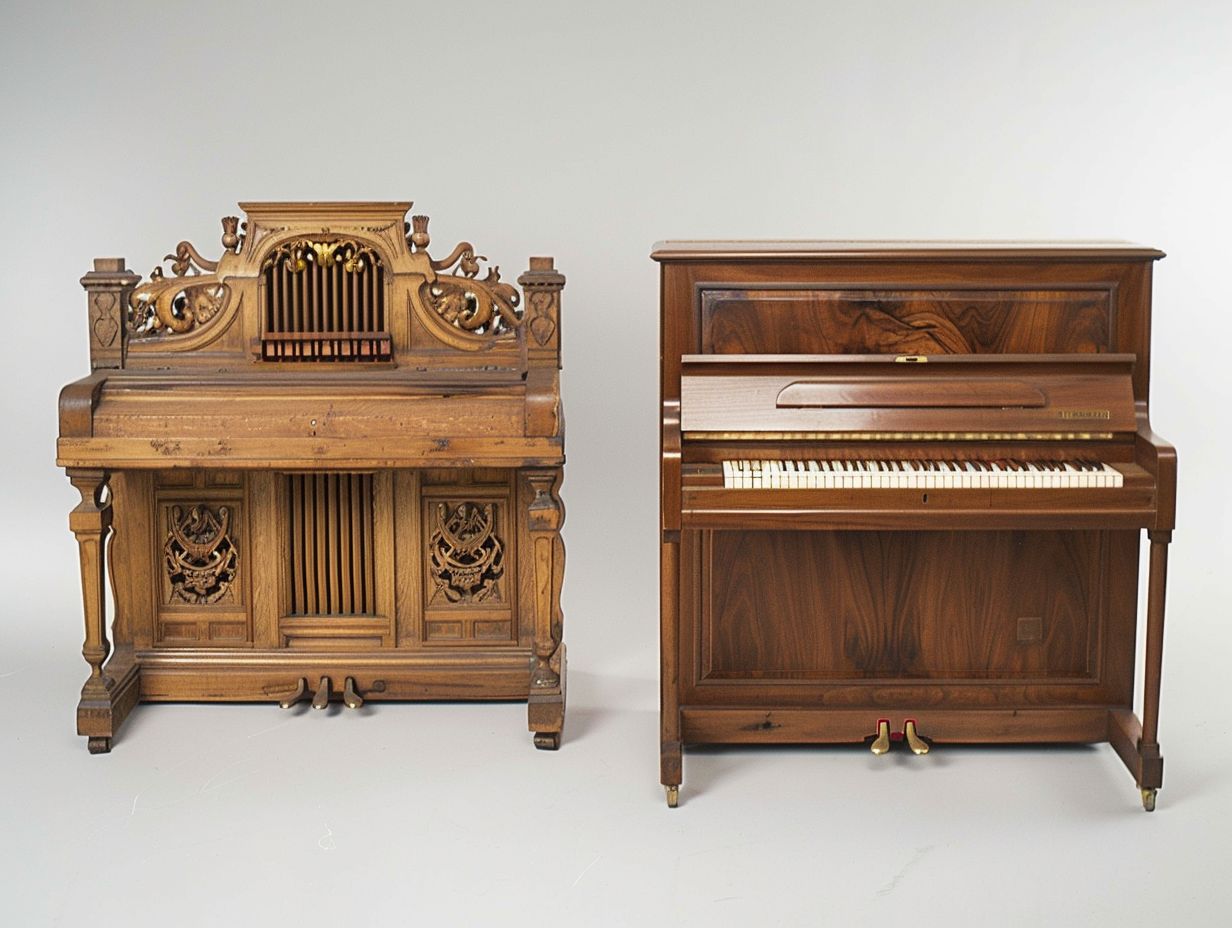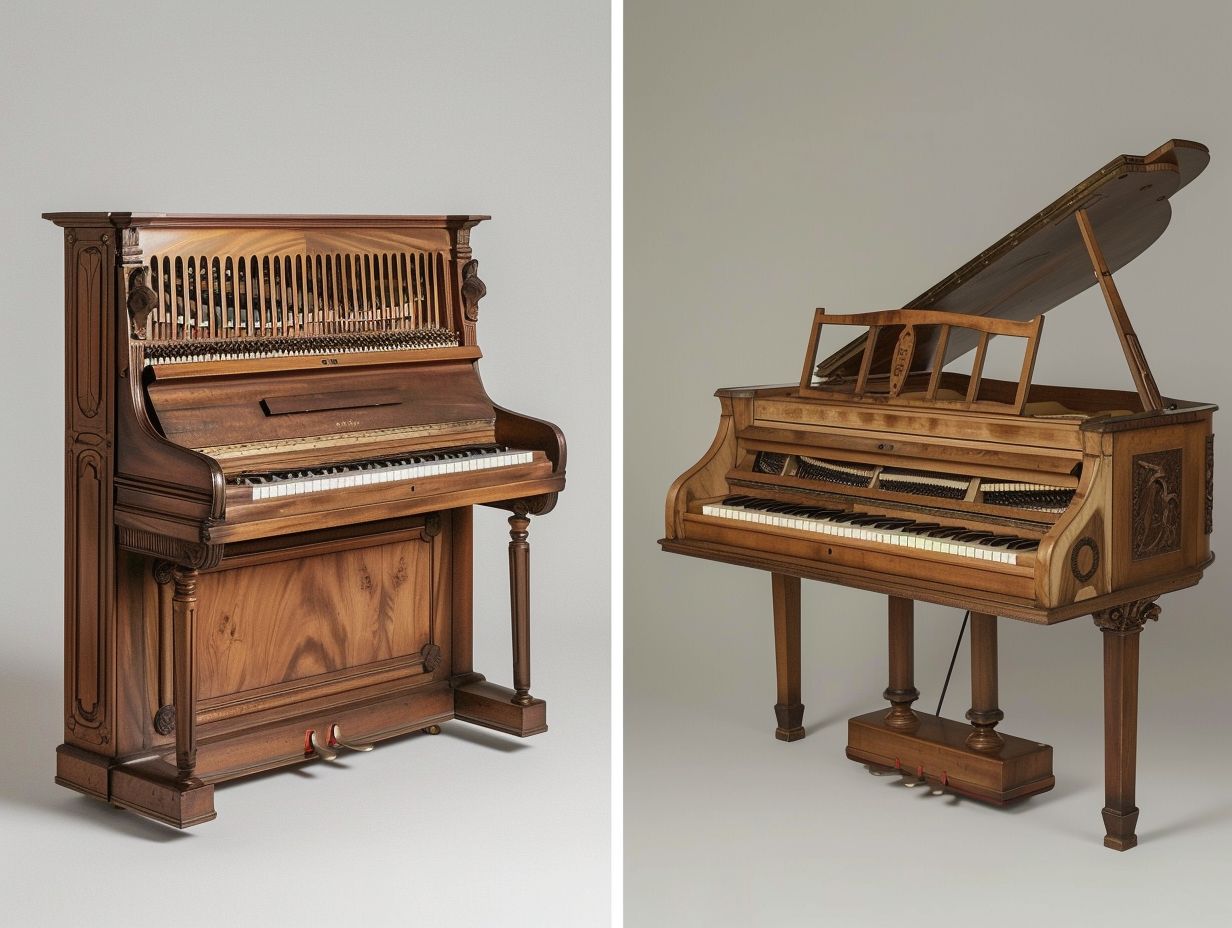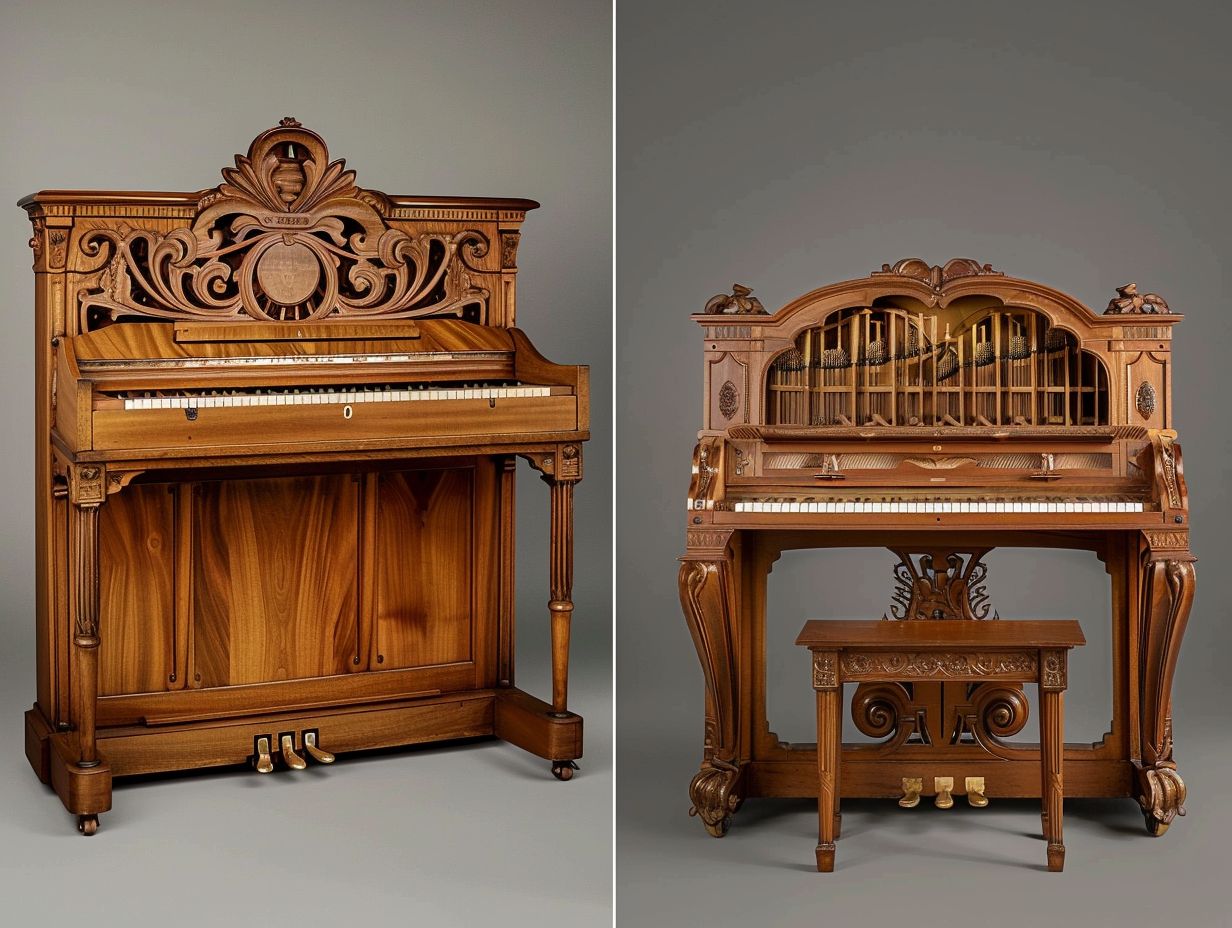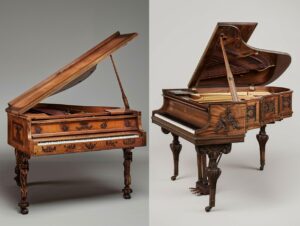Are you in the market for a new piano but unsure whether to choose a spinet or console model? Understanding the key differences between these two types of pianos is essential in making the right decision for your musical needs.
We will explore the unique characteristics of spinet and console pianos, weigh the pros and cons of each, and provide valuable insights on factors to consider when choosing between the two.
Discover maintenance tips to keep your piano in top condition. Whether you prioritize space-saving features or optimal sound quality, this article will help you make an informed choice.
| Aspect |
Spinet Piano |
Console Piano |
| Size |
Smaller, typically 36 to 40 inches in height |
Larger, typically 43 to 47 inches in height |
| Action Mechanism |
Drop action, lighter touch |
Direct blow action, more substantial key response |
| Sound Quality |
Brighter, more focused tonal quality |
Richer, deeper tonal quality |
| Soundboard |
Smaller soundboard |
Larger soundboard |
| String Length |
Shorter strings |
Longer strings |
| Portability |
Easier to move due to smaller size and lighter weight |
More difficult to move due to larger size and weight |
| Cost |
More affordable |
Generally more expensive |
| Maintenance |
Requires regular tuning and occasional repairs |
Requires more extensive tuning and maintenance |
| Space Suitability |
Suitable for small living spaces and apartments |
Requires more space, suitable for larger rooms |
| Playing Experience |
Suitable for beginners, lighter touch |
Suitable for more advanced players, richer sound |
| Sound Projection |
Less resonant, suitable for confined spaces |
More resonant, suitable for larger rooms |
| Design and Aesthetics |
Compact, fits well in tight spaces |
Taller, more imposing presence in a room |
| Usage |
Ideal for practice and small performances |
Suitable for practice and larger performances |
| Maintenance Complexity |
Simpler maintenance |
More complex maintenance due to larger structure |
| Initial and Ongoing Costs |
Lower initial cost, lower maintenance cost |
Higher initial cost, higher maintenance cost |
| Professional Recommendation |
Recommended for beginners and budget-conscious buyers |
Recommended for serious learners and advanced players |
Understanding the Differences between Spinet and Console Pianos

Comprehending the distinctions between Spinet and Console Pianos holds significant importance for pianists contemplating an investment in a new musical instrument. While both the Spinet Piano and Console Piano are classified as upright pianos, they exhibit individual features and characteristics that differentiate them.
Spinet Pianos, known for their reduced height, are particularly suitable for spaces with limited dimensions, unlike Console Pianos which stand taller and deliver a more robust sound projection. Regarding their construction, Spinet Pianos incorporate a vertically positioned internal action, leading to a more compact structure. In contrast, Console Pianos house a horizontally placed action assembly, providing a smoother touch and enhanced control.
When considering sound quality, Console Pianos are often favored for their resonant and sonorous tonal quality attributed to their larger soundboard, whereas Spinet Pianos may yield a slightly brighter tonal profile. Both types of pianos feature an array of finishes and design options to complement diverse interior settings, accommodating the aesthetic preferences of musicians and enthusiasts.
What Makes a Spinet Different from a Console Piano?
The primary distinctions between a Spinet Piano and a Console Piano are rooted in their size, action mechanisms, and overall sound characteristics. Spinet Pianos are recognized for their compact dimensions and distinctive action, whereas Console Pianos present a larger structural framework and a distinctively nuanced playing encounter.
Spinet Pianos typically incorporate a sophisticated action mechanism referred to as drop action, where the hammers are positioned in close proximity to the keys, resulting in a lighter touch. This configuration enables rapid note repetition, making it particularly suitable for novice players and for performing musical genres that require a lighter touch.
In contrast, Console Pianos often showcase a direct blow action, delivering a more substantial key response and a richer sound projection. Spinets commonly feature a smaller soundboard in comparison to the larger soundboard present in Console Pianos, influencing their resonance and tonal attributes.
Pros and Cons of Spinet Pianos
Spinet Pianos present a combination of advantages and disadvantages that are pertinent for musicians and enthusiasts to consider. Their compact size and relatively low cost render them accessible to a broad spectrum of players; however, factors pertaining to sound quality and maintenance must be duly acknowledged.
Notwithstanding their diminutive dimensions, Spinet Pianos offer a robust and resonant sound, ideally suited for practice or performance in confined spaces. Although their smaller size may constrain the depth and fullness of tones compared to larger pianos, the utility of their ability to fit into constrained spaces is a notable benefit. Furthermore, the affordability of Spinet Pianos serves as a significant advantage, allowing aspiring musicians to procure a quality instrument without incurring exorbitant costs.
It is imperative to adhere to regular maintenance practices to uphold the longevity and operational efficiency of a Spinet Piano. This entails periodic tuning and occasional repairs to preserve its quality over time.
Benefits and Limitations of Spinet Pianos
Spinet pianos are renowned for their compact dimensions and cost-effectiveness, rendering them particularly suitable for small living spaces and budget-conscious clientele. These pianos, while offering advantages in terms of size and price, may present certain limitations in sound quality when compared to larger and more sophisticated models, necessitating consistent upkeep to ensure their durability.
Despite their reduced physical footprint, spinet pianos can still deliver melodious tones suitable for practice sessions or leisurely play. The economical nature of spinet pianos makes them an appealing option for beginners or individuals with spatial constraints in their residences. It is imperative to engage in regular maintenance practices, such as tuning and meticulous care of internal components, to avert potential degradation and sustain optimal performance levels. Although they may not rival the rich, resonant tones of grand pianos, spinet pianos offer a satisfactory sound profile relative to their size. Their combination of convenience and affordability renders them a pragmatic selection for numerous musicians.
Pros and Cons of Console Pianos
Console pianos offer a unique set of advantages and disadvantages in comparison to other upright piano models. The larger dimensions of console pianos contribute to an improved sound quality, resembling the richness and resonance often associated with grand pianos. This enhanced tonal quality is particularly advantageous for musicians who desire a fuller and more dynamic sound experience.
However, the size and weight of console pianos may present challenges in terms of space requirements and transportation logistics. Due to their larger size, these instruments necessitate more substantial space within a home and can be difficult to move. Additionally, the maintenance and tuning of console pianos are more intricate and may incur higher costs and time commitments compared to smaller upright pianos.
Benefits and Limitations of Console Pianos

Console Pianos are distinguished by their superior sound quality, attributed to their larger size and longer strings, which result in a rich and resonant tone. However, it is important to acknowledge that these instruments necessitate more extensive maintenance and space as compared to smaller upright piano models.
On a positive note, the larger dimensions of Console Pianos facilitate enhanced sound projection, rendering them well-suited for larger rooms or performance venues. Furthermore, the longer strings of these instruments contribute to a nuanced and intricate sound, thereby enriching the overall musical experience. Console Pianos are often regarded as aesthetically pleasing pieces of furniture capable of enhancing the ambiance of a room.
It should be emphasized that ownership of a Console Piano entails heightened maintenance requirements, encompassing tuning and regular upkeep to uphold its optimal sound quality. Owing to their substantial size, Console Pianos may not be suitable for smaller living spaces or apartments with limited accommodations for such an instrument of significant magnitude.
Factors to Consider when Choosing between a Spinet and Console Piano
When faced with the decision between a Spinet and a Console Piano, several key considerations must be taken into account, such as size preferences, desired sound quality, and financial constraints. An understanding of these factors is essential for individuals to make an informed decision tailored to their specific requirements.
The size differential is a significant factor to consider, as Spinets generally feature a smaller, more compact design in comparison to Console Pianos, which are larger and heavier. This variation in size can influence the placement of the instrument within a room and its overall aesthetic appeal.
Furthermore, there are distinctions in sound characteristics, with Spinets typically producing a softer and less resonant tone when contrasted with the fuller sound of Console Pianos. Pricing discrepancies also play a crucial role, as Spinets are often more economically accessible than Console Pianos, rendering them a viable option for those operating within a constrained budget.
It is imperative for prospective buyers to meticulously evaluate these factors to strike the appropriate balance between size, sound quality, and price.
Size and Space Requirements
One of the key considerations in selecting between a Spinet and Console Piano is the spatial requirements. Spinets are characterized by their compact size and shorter keys, making them a suitable choice for environments with limited space. On the other hand, Console Pianos feature a taller upright design, which may necessitate more room for placement.
Typically, Spinets have dimensions ranging from 36 to 40 inches in height, making them well-suited for smaller living areas or apartments with space constraints. Conversely, Console Pianos can reach heights of 43 to 47 inches, offering a more imposing presence in a room but demanding a larger area for installation.
The key lengths on a Spinet are marginally shorter compared to those on a Console Piano, impacting the overall sound projection and playability, particularly for musicians with varying preferences.
Sound Quality and Tone
The quality of sound and tone are pivotal factors in the selection process between a Spinet and Console Piano. Differential characteristics such as the design of the soundboard, length of strings, and nuanced sound properties significantly distinguish these instruments, thereby influencing the overall musical experience for players.
In the realm of piano selection, the construction of the soundboard holds paramount importance, as it directly impacts the resonance and projection capabilities of the instrument. Spinets, renowned for their compact dimensions, are often equipped with smaller soundboards, leading to a brighter and more focused tonal quality. In contrast, Console Pianos exhibit larger soundboards, facilitating the production of richer and deeper tones.
Moreover, the varying lengths of strings contribute significantly to the distinctive tonal attributes of each piano variant. Spinets, characterized by shorter strings, offer a sound profile that stands in sharp contrast to the longer strings typically found in Console Pianos.
Price and Budget
Price and budget considerations play a vital role in the decision-making process between a Spinet and a Console Piano. Spinets are generally considered more economically feasible options, catering to individuals with budget constraints, whereas Console Pianos may offer superior sound quality at a higher price point.
Spinets, characterized by their compact dimensions and simpler structural design, typically present a more cost-efficient alternative in comparison to Console Pianos, which are larger and feature more intricate craftsmanship. While Spinets may serve as a pragmatic selection for beginners or individuals with limited space availability, Console Pianos are often the instrument of choice for professional musicians due to their enhanced tonal depth and resonance, albeit at a premium cost.
It is imperative for prospective purchasers to carefully assess their priorities concerning affordability and sound quality when deliberating between these two piano variants.
Maintenance and Care for Spinet and Console Pianos

Proper maintenance and care are fundamental aspects of owning Spinet and Console Pianos. Regular tuning, repair, cleaning routines, and appropriate storage practices play a crucial role in extending the lifespan and maintaining the playing condition of these instruments, ensuring optimal performance throughout their usage.
Tuning stands as a pivotal maintenance task for pianos, contributing to the instrument’s harmonious sound production and internal harmony. Scheduling routine tuning sessions with a professional piano technician is recommended to uphold the correct pitch and tone quality consistently.
Timely repairs should be promptly addressed to prevent minor issues from escalating into significant problems that could hinder the piano’s playability. Regular cleaning of the piano using a soft, dry cloth aids in the removal of dust and fingerprints, with the caution of avoiding harsh chemicals that may compromise the finish.
Adhering to proper storage practices, such as shielding the piano from direct sunlight and extreme humidity, is critical in safeguarding the wood and internal components against damage.
Tuning and Repairs
The maintenance tasks of tuning and repairs are of utmost importance for both Spinet and Console Pianos, necessitating the expertise of qualified technicians. Engaging professional piano tuners and technicians from reputable piano stores is crucial in order to ensure that these instruments are maintained in optimal playing condition and retain their sound quality.
Regular maintenance checks play a significant role in preventing costly repairs in the future. Through consistent inspections of pianos, potential issues can be identified early and addressed promptly, ultimately extending the lifespan of the instrument.
Piano technicians possess specialized knowledge and tools essential for fine-tuning the intricate components of Spinets and Console Pianos, ensuring that each key produces the desired tone. By entrusting reputable piano stores for tuning and repair services, piano owners can revel in the harmonious melodies of their cherished instruments for years to come.
Cleaning and Storage
Cleanliness and proper storage practices play a crucial role in preserving the aesthetics and functionality of Spinet and Console Pianos. To ensure the longevity of these instruments and protect them from dust, humidity, and other potential damages, it is advisable to engage the services of a qualified technician for detailed cleaning tasks and to implement appropriate storage methods.
Professional technicians possess the requisite expertise to handle the intricate components of pianos, including delicate keys and internal mechanisms, ensuring a comprehensive and gentle cleaning process. By utilizing specialized tools and solutions, they can effectively eliminate accumulated dirt and debris without compromising the integrity of the instrument.
In terms of storage, pianos should be situated in a well-ventilated area that is shielded from direct sunlight and extreme temperature fluctuations. Covering the piano with a breathable cloth can serve as a protective barrier against dust while facilitating airflow to prevent moisture accumulation.
Frequently Asked Questions
What is the difference between a spinet and a console piano?
A spinet piano is smaller in size and has a drop action, while a console piano is larger and has a direct blow action. This affects the tone and touch of the instrument.
Which is better for beginners, a spinet or a console piano?

For beginners, a spinet piano is often recommended because of its smaller size and lower cost. However, a console piano may provide a more realistic feel and sound for those serious about learning and improving their skills.
Can a spinet piano produce the same quality of sound as a console piano?
No, due to its smaller size and drop action, a spinet piano may not produce the same depth and richness of sound as a console piano. However, modern advancements in technology have allowed for spinet pianos to have improved sound quality.
Which one is easier to move, a spinet or a console piano?
A spinet piano is generally easier to move due to its smaller size and lighter weight. However, both types of pianos should be moved by professional piano movers to ensure their safety and proper handling.
Is there a significant price difference between a spinet and a console piano?
Yes, there is usually a significant price difference between a spinet and a console piano. Spinet pianos are typically less expensive due to their smaller size, while console pianos can cost more due to their larger size and more advanced features.
Which type of piano is more commonly used in homes, a spinet or a console piano?
Both spinet and console pianos are commonly used in homes, but it often depends on personal preference and available space. Spinets are better for smaller living spaces, while console pianos are more suitable for larger rooms and music studios.







